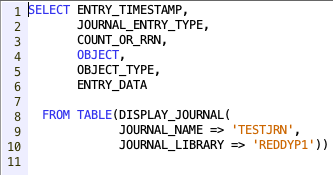What happens if Journal Sequence Number reaches its Maximum Value?
Journals on IBM i makes life easier when something goes wrong.
But, What if application starts failing because of Journal Receiver? This can happen in different scenarios. Here is the one scenario I have seen recently.
"Journal sequence number is at the maximum value"
As the error suggests, Journal Receiver reached it's maximum sequence number and it cannot log any more entries into Journal.
Maximum allowed sequence number on a Journal receiver is 9,999,999,999.
We will see a bit about when this may occur and How to resolve it.
What happens when Sequence Number reaches it's maximum value?
Job would throw error 'Entry not journaled to journal &1. Reason code &3' (CPF7003) while adding an entry into Journal Receiver. Reason code would be '4' (4 -- Journal sequence number is at the maximum value.) in this case.
There can be two scenarios when this issue occurs.
- Journal Receiver starts with sequence number '1' and reaches 9,999,999,999. This could occur very rarely and only if an application is fairly large and/or Journal Receiver isn't changed for a lone time.
- Journal Receiver starts with next sequence number from the previously attached Receiver and reaches maximum. This could occur frequently as CHGJRN would create the new Receiver with one greater than the sequence number of the last journal entry in the currently attached journal receiver.
What to do if Sequence Number reaches it's maximum value?
CHGJRN command to be issued to generate new Receiver with an option to Reset the Sequence Number to '1'
CHGJRN JRN(LIBRARY/JOURNAL) JRNRCV(*GEN) SEQOPT(*RESET)
This would detach the current receiver and attach the new receiver to start from Sequence Number '1'.
There could be error in executing this command if there are pending changes to be committed on the current receiver. These changes should be committed or Rollback for CHGJRN to execute.
Here is how you could find the pending Commitment definitions.
DSPJRNRCVA JRNRCV(JOURNAL_RECEIVER)
F10=Work with journal attributes
(OR)
WRKJRNA JRN(JOURNAL)
F19=Display journaled objects
Option 6. Commitment Definitions
This would display pending commitment definitions. COMMIT or ROLLBACK needs to be run for the pending changes on these Jobs.
Once these are resolved, CHGJRN should run fine.



@Pradeep; nice job on documenting this behavior. Two notes though.
ReplyDeleteJournal attribute RCVSIZOPT(*MAXOPT3) supports a JE Sequence of 18,446,744,073,709,551,600
IPLs "can" reset the JE Sequence; which it does once it reaches a threshold, though I don't know what that number is. If you use RCVJRNE, then this becomes problematic because the reset isn't guaranteed, and that under certain circumstances (like multiple IPL's due to an O/S upgrade), which makes singular use of the JE Sequence number to drive processes unreliable -- recommend using Journal Receiver and Timestamp as a restart point.
Thanks again for your content.
Thanks a lot for the info TimH. I will make a note of these.
Delete